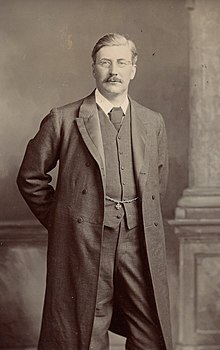
Back فرانك راسل، إيرل راسل الثاني Arabic فرانك راسل ايرل راسل التانى ARZ Frank Russell, 2. Earl Russell German Frank Russell, 2º. Earl Russell Spanish فرنک راسل، ارل راسل دوم Persian Francis Russell (2e comte Russell) French 제2대 러셀 백작 프랭크 러셀 Korean فرانک راسل، دویم ارل راسل Pashto/Pushto Рассел, Фрэнк, 2-й граф Рассел Russian
The Earl Russell | |
|---|---|
 Frank Russell, c. 1901 | |
| Parliamentary Under-Secretary of State for India | |
| In office 1 December 1929 – 3 March 1931 | |
| Monarch | George V |
| Prime Minister | Ramsay MacDonald |
| Preceded by | Drummond Shiels |
| Succeeded by | The Lord Snell |
| Parliamentary Secretary to the Ministry of Transport | |
| In office 11 June 1929 – 1 December 1929 | |
| Monarch | George V |
| Prime Minister | Ramsay MacDonald |
| Preceded by | John Moore-Brabazon (1927) |
| Succeeded by | Arthur Ponsonby |
| Member of the House of Lords | |
| Hereditary peerage 13 August 1886 – 3 March 1931 | |
| Preceded by | John Russell, 1st Earl Russell (1878) |
| Succeeded by | Bertrand Russell, 3rd Earl Russell |
| Personal details | |
| Born | John Francis Stanley Russell 12 August 1865 Nether Alderley, Cheshire, England |
| Died | 3 March 1931 (aged 65) Marseilles, France |
| Spouses |
|
| Parent(s) | Viscount and Viscountess Amberley |
John Francis Stanley Russell, 2nd Earl Russell, known as Frank Russell (12 August 1865 – 3 March 1931), was a British nobleman, barrister and politician, the elder brother of the philosopher Bertrand Russell, and the grandson of John Russell, 1st Earl Russell, who was twice prime minister of Britain. The elder son of Viscount and Viscountess Amberley, Russell became well-known for his marital woes, and was convicted of bigamy before the House of Lords in 1901, the last peer to be convicted of an offence in a trial by the Lords before that privilege of peerage was abolished in 1948.
Russell was raised by his paternal grandparents after his unconventional parents both died young. He was discontented living with his grandparents, but enjoyed four happy years at Winchester College. His academic education came to a sudden end when he was sent down from Balliol College, Oxford, probably because authorities there had suspicions concerning the nature of his relationship with the future poet Lionel Johnson, and he always bitterly resented his treatment by Oxford. After spending time in the United States, he married the first of his three wives, Mabel Edith Scott, in 1890. The two quickly separated, and the next several years saw acrimonious litigation in the courts, but the restrictive English laws of the time meant there was no divorce. Russell was elected to the London County Council in 1895, and served there until 1904. In 1899, he accompanied the woman who would become his second wife, Mollie Somerville, to Nevada, where each obtained a divorce, and they married, then returned to Britain to live as husband and wife. Russell was the first celebrity to get a Nevada divorce, but it was not recognised by English law, and in June 1901, he was arrested for bigamy. He pleaded guilty before the House of Lords, and served three months in Holloway, afterwards marrying Mollie according to English law. He gained a free pardon for the offence in 1911.
Beginning in 1902 Russell campaigned for divorce law reform, using his hereditary seat as a peer in the House of Lords to advocate this, but had little success. He was also a campaigner for motorists' rights, often taking briefs to defend them after being called to the bar in 1905, and at one time had the registration number plate A 1. His second marriage ended after he fell in love with the novelist Elizabeth von Arnim in 1914, and he married von Arnim in 1916. The couple soon separated, though they did not divorce, and Elizabeth caricatured him in her novel Vera, to his anger. Frank Russell aided his brother Bertrand when he was imprisoned for anti-war activities in 1918. Increasingly aligned with the Labour Party, Russell was given junior office in the second MacDonald government in 1929, but his ministerial career was cut short by his death in 1931. Despite his achievements, Frank Russell is obscure compared to his brother and grandfather, and his marital difficulties led to his being dubbed the "Wicked Earl".